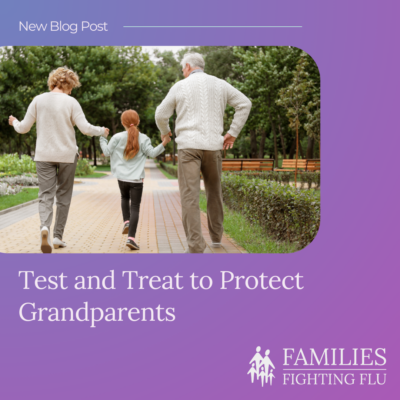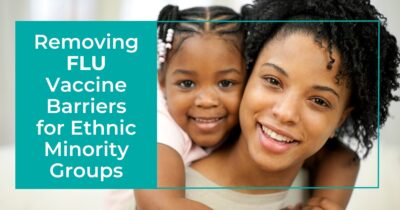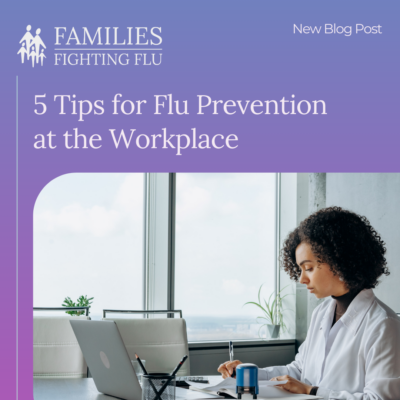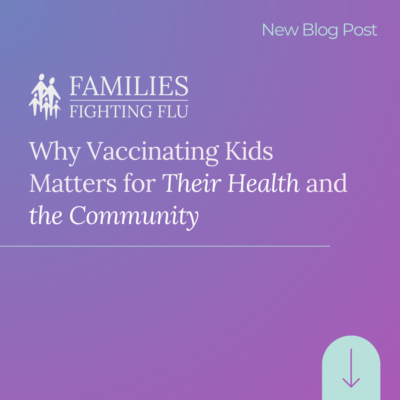
- Flu Prevention
Removing Flu Vaccine Barriers for Ethnic Minority Groups

A recent CDC report showed that flu hospitalization rates were nearly 80 percent higher among Black adults than White adults from 2009–2022. The flu is highly contagious, even deadly, for anyone – regardless of age, race, or health status, and the flu vaccination is the best way to protect against the flu. But the reality is less than 43 percent of Black, Hispanic, and American Indian/Alaska Native adults were vaccinated during the 2021–2022 flu season. People from these groups face barriers when it comes to health care in general, and as a group, they lack easy access to vaccination. That’s why it’s so important that everyone receives the right information, the right care, and more access to stay protected against the flu.
People from some racial and ethnic minority groups are at a disadvantage regarding health care. For example, in the past year, Hispanic adults were less likely to have insurance, a healthcare provider, and a checkup. Last flu season, it showed that adults who did in fact have these things – insurance, a healthcare provider, and a medical checkup in the past year – were more likely to get a flu vaccine compared with those without. Another factor is a lack of access to culturally competent providers, which is another barrier to vaccination for many people from these groups.
When interviewed about the report, CDC Acting Principal Deputy Director Dr. Debra Houry said, “During my time as an ER doc, and throughout my work at CDC, I’ve seen that the reasons behind inequities and vaccination coverage for people from some racial and ethnic minority groups are systemic and a result of many factors. I’ve also seen the impact vaccination can have to reduce the impact illnesses like flu can have on our society.”
Instilling Vaccine Confidence
As we saw with the 2020 COVID-19 pandemic, there is vaccine hesitancy and misinformation, especially in certain groups like the Black community. The fact of the matter is that flu vaccination is safe. Flu vaccines have been used for over 50 years and are safely administered to millions of people every year. The CDC and the FDA continuously monitor the safety of all vaccines. New vaccines must go through a series of research and clinical trials before they are deemed safe and effective for the general public. The flu shot is also highly effective; it can reduce the chances of getting sick with the flu by up to 60 percent. Sometimes sharing these facts isn’t enough. As cited in this study by UCLA, personal experiences tend to heighten the Black community’s distrust of the healthcare system and lead to skepticism about vaccines.
One example of how to overcome this was from Baltimore resident Rev. Dr. Terris King, pastor of Liberty Grace Church of God. He recognized this hesitancy among the Black community in his area. He partnered with the International Vaccine Access Center (IVAC) at Johns Hopkins University to create an environment where congregants felt comfortable asking questions about vaccines. Rev. Dr. King made this information relevant to the community and connected with congregants in a way others could not. IVAC also partnered with the city of Baltimore and its partners to bring vaccine administration sites closer to people and the places they trust, which added a layer of convenience and comfortability.
So what else can be done? The CDC report has actionable steps to take. These include:
- Promote Community-Based Vaccination (like the example in Baltimore)
- Use Culturally Responsive Messages
- Partner with Trusted Messengers
- Emphasize Flu Vaccination
The Partnering for Vaccine Equity (P4VE) program is one example, which aims to reduce disparities in adult vaccination. These partnerships seek to build trust, increase access to vaccination, and combat misinformation. Since its launch, it has provided over $156 million in funding to 500+ partners at the national, state, and local levels working in 225+ cities and all 50 states.
There have also been several campaigns targeted toward Black and Hispanic audiences, such as Get My Flu Shot from the Ad Council, American Medical Association, and CDC, helping to build more confidence and trust in vaccines. After two years, concerns about flu vaccine risks or side effects decreased from 43 to 33 percent among Black adults and 41 to 32 percent among Hispanic adults.
There is still much work to be done to give some racial and ethnic minority groups the same advantages and access to health care and vaccines as others. Flu can lead to difficulty breathing, and every year in the U.S., the flu and associated complications lead to more than 200,000 hospitalizations and tens of thousands of deaths. Let’s do our part by understanding the challenges and barriers and advancing equity so all people have access to fight the flu.


